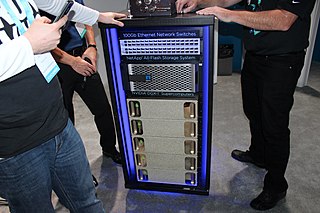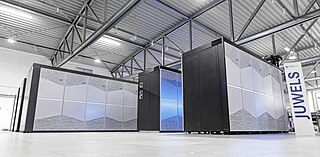In computing, floating point operations per second is a measure of computer performance, useful in fields of scientific computations that require floating-point calculations. For such cases, it is a more accurate measure than measuring instructions per second.
Cray Inc., a subsidiary of Hewlett Packard Enterprise, is an American supercomputer manufacturer headquartered in Seattle, Washington. It also manufactures systems for data storage and analytics. Several Cray supercomputer systems are listed in the TOP500, which ranks the most powerful supercomputers in the world.

MareNostrum is the main supercomputer in the Barcelona Supercomputing Center. It is the most powerful supercomputer in Spain, one of thirteen supercomputers in the Spanish Supercomputing Network and one of the seven supercomputers of the European infrastructure PRACE.
The Oak Ridge Leadership Computing Facility (OLCF), formerly the National Leadership Computing Facility, is a designated user facility operated by Oak Ridge National Laboratory and the Department of Energy. It contains several supercomputers, the largest of which is an HPE OLCF-5 named Frontier, which was ranked 1st on the TOP500 list of world's fastest supercomputers as of June 2023. It is located in Oak Ridge, Tennessee.

The TOP500 project ranks and details the 500 most powerful non-distributed computer systems in the world. The project was started in 1993 and publishes an updated list of the supercomputers twice a year. The first of these updates always coincides with the International Supercomputing Conference in June, and the second is presented at the ACM/IEEE Supercomputing Conference in November. The project aims to provide a reliable basis for tracking and detecting trends in high-performance computing and bases rankings on HPL benchmarks, a portable implementation of the high-performance LINPACK benchmark written in Fortran for distributed-memory computers.
The Green500 is a biannual ranking of supercomputers, from the TOP500 list of supercomputers, in terms of energy efficiency. The list measures performance per watt using the TOP500 measure of high performance LINPACK benchmarks at double-precision floating-point format.

Jaguar or OLCF-2 was a petascale supercomputer built by Cray at Oak Ridge National Laboratory (ORNL) in Oak Ridge, Tennessee. The massively parallel Jaguar had a peak performance of just over 1,750 teraFLOPS. It had 224,256 x86-based AMD Opteron processor cores, and operated with a version of Linux called the Cray Linux Environment. Jaguar was a Cray XT5 system, a development from the Cray XT4 supercomputer.

Tianhe-I, Tianhe-1, or TH-1 is a supercomputer capable of an Rmax of 2.5 peta FLOPS. Located at the National Supercomputing Center of Tianjin, China, it was the fastest computer in the world from October 2010 to June 2011 and was one of the few petascale supercomputers in the world.
Exascale computing refers to computing systems capable of calculating at least "1018 IEEE 754 Double Precision (64-bit) operations (multiplications and/or additions) per second (exaFLOPS)"; it is a measure of supercomputer performance.

Several centers for supercomputing exist across Europe, and distributed access to them is coordinated by European initiatives to facilitate high-performance computing. One such initiative, the HPC Europa project, fits within the Distributed European Infrastructure for Supercomputing Applications (DEISA), which was formed in 2002 as a consortium of eleven supercomputing centers from seven European countries. Operating within the CORDIS framework, HPC Europa aims to provide access to supercomputers across Europe.

Nvidia DGX is a line of Nvidia-produced servers and workstations which specialize in using GPGPU to accelerate deep learning applications. The typical design of a DGX system is based upon a rackmount chassis with motherboard that carries high performance x86 server CPUs. The main component of a DGX system is a set of 4 to 16 Nvidia Tesla GPU modules on an independent system board. DGX systems have large heatsinks and powerful fans to adequately cool thousands of watts of thermal output. The GPU modules are typically integrated into the system using a version of the SXM socket or by a PCIe x16 slot.

AMD Instinct is AMD's brand of professional GPUs. It replaced AMD's FirePro S brand in 2016. Compared to the Radeon brand of mainstream consumer/gamer products, the Instinct product line is intended to accelerate deep learning, artificial neural network, and high-performance computing/GPGPU applications.

Sierra or ATS-2 is a supercomputer built for the Lawrence Livermore National Laboratory for use by the National Nuclear Security Administration as the second Advanced Technology System. It is primarily used for predictive applications in nuclear weapon stockpile stewardship, helping to assure the safety, reliability, and effectiveness of the United States' nuclear weapons.

Hewlett Packard Enterprise Frontier, or OLCF-5, is the world's first exascale supercomputer. It is hosted at the Oak Ridge Leadership Computing Facility (OLCF) in Tennessee, United States and became operational in 2022. As of December 2023, Frontier is the world's fastest supercomputer. It is based on the Cray EX and is the successor to Summit (OLCF-4). Frontier achieved an Rmax of 1.102 exaFLOPS, which is 1.102 quintillion operations per second, using AMD CPUs and GPUs.

ROCm is an Advanced Micro Devices (AMD) software stack for graphics processing unit (GPU) programming. ROCm spans several domains: general-purpose computing on graphics processing units (GPGPU), high performance computing (HPC), heterogeneous computing. It offers several programming models: HIP, OpenMP/Message Passing Interface (MPI), OpenCL.
The European High-Performance Computing Joint Undertaking is a public-private partnership in High Performance Computing (HPC), enabling the pooling of European Union–level resources with the resources of participating EU Member States and participating associated states of the Horizon Europe and Digital Europe programmes, as well as private stakeholders. The Joint Undertaking has the twin stated aims of developing a pan-European supercomputing infrastructure, and supporting research and innovation activities. Located in Luxembourg City, Luxembourg, the Joint Undertaking started operating in November 2018 under the control of the European Commission and became autonomous in 2020.

JUWELS is a supercomputer developed by Atos Forschungszentrum Jülich, capable of 70.980 petaflops. It replaced the now disused JUQUEEN supercomputer. JUWELS Booster Module is ranked as the eight fastest supercomputer in the world. The JUWELS Booster Module is part of a modular system architecture and a second Xeon based JUWELS Module ranks separately as the 52nd fastest supercomputer in the world.

Leonardo is a petascale supercomputer located at the CINECA datacenter in Bologna, Italy. The system consists of an Atos BullSequana XH2000 computer, with close to 14,000 Nvidia Ampere GPUs and 200Gbit/s Nvidia Mellanox HDR InfiniBand connectivity. Inaugurated in November 2022, Leonardo is capable of 250 petaflops, making it one of the top five fastest supercomputers in the world. It debuted on the TOP500 in November 2022 ranking fourth in the world, and second in Europe.
HPC5 is a supercomputer built by Dell and installed by Eni, capable of 51.721 petaflops, and is ranked 9th in the Top500 as of November 2021. It is located in the Green Data Center in Ferrera Erbognone, in Northern Italy. In June 2020, HPC5 ranked 6th in the Green500. HPC5 is an upgrade to the HPC4 system, which was built by Hewlett Packard Enterprise and used by Eni. It is also called as HPC4+.
Hewlett Packard Enterprise El Capitan, is an upcoming exascale supercomputer, hosted at the Lawrence Livermore National Laboratory in Livermore, United States and projected to become operational in 2024. It is based on the Cray EX Shasta architecture. When deployed, El Capitan is projected to displace Frontier as the world's fastest supercomputer.












